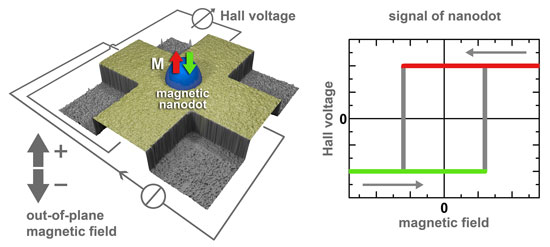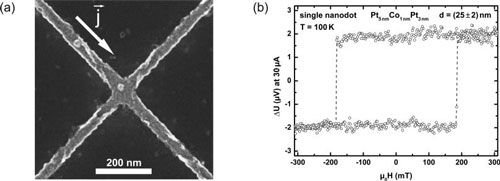| Posted: May 14, 2013 | |
Probing the behavior of single nanomagnets |
|
| (Nanowerk Spotlight) Ferromagnetic materials exhibit the so-called anomalous Hall effect (AHE), whereby the electrons flowing through the material experience a lateral force pushing them to one side as a result of the material's intrinsic magnetization. The AHE has deep roots in the history of electricity and magnetism. In 1879 Edwin H. Hall made the momentous discovery that, when a current-carrying conductor is placed in a magnetic field, the Lorentz force 'presses' its electrons against one side of the conductor. The AHE stems from the material's own magnetization rather than from an external field (take a look at this paper if you are interested in a review of experimental and theoretical studies of the AHE: "Anomalous Hall effect") | |
| Although the AHE has been used in the field on nanotechnology to measure the magnetic behavior of nanoparticles (with sizes larger than 50 nm), nobody so far had tried to separate the signals of the individual particles. Researchers in Germany have now developed a simple technique which allows to measure the magnetic response of single ferromagnetic nanoparticles down to a radius of about 3.3 nm. This comes close to the sensitivity of the microSQUID technique. | |
| The team, led by Hans Peter Oepen, a professor in the Institute for Applied Physics at the University of Hamburg, demonstrated that local sources for an AHE yield certain fingerprints in the macroscopically measured voltages that give an indication to the position of the source. They reported their findings in a recent online issue of Nano Letters ("Probing the Magnetic Behavior of Single Nanodots"). | |
 |
|
| A schematic of the measurement principle for a single nanoparticle. (Image: Alexander Neumann, University of Hamburg) | |
| "Initially, we had focused on the fabrication of nanostructures with tunable properties, which in itself is a formidable task," Alexander Neumann, a PhD student in Oepen's group and the paper's first author, tells Nanowerk. "We succeeded in creating large ensembles of nanodots in the range of < 30 nm which are carved out of Pt/Co/Pt multilayer thin-film via ion-milling. To study the behavior of the nanodots we then looked for a method with appropriate sensitivity." | |
| To address the issue of multiple interactions that are influencing the behavior of ensembles of nanostructures the researchers decided to look at single nanostructures and focus on their interactions. An important prerequisite was that the method should be as simple as possible. | |
| In addition to a simple technique that allows to measure the magnetic response of single ferromagnetic nanoparticles, the team was able to develop a procedure to identify the magnetic response of individual nanoparticles in a small ensembles. Interestingly, they found that apparently identical particles are behaving different – Even when the dots seem to have the same volumes, the signal height or the reversal characteristics can vary. | |
| "The latter is important so that we can simultaneously study single particle behavior utilizing a multiple particle arrangement (saving time) and, even more interestingly, we can investigate the interaction on the single particle behavior in the future," says Neumann. "In comparison to other techniques with single nanoparticle sensitivity, our approach is not limited with respect to temperature, magnetic field, or ideal systems." | |
| The main features of the method are the fabrication of cylindrical nanomagnets and a Hall cross, which was fabricated by means of electron beam lithography within the seed layer for the nanomagnets. | |
 |
|
| SEM micrograph and AHE signal versus field of a Hall cross containing a single dot. (a) The dimensions of the Hall cross that is created in the Pt seed layer are 3 nm/45 nm (thickness/width). The Co layer of the nanodot has a thickness of 1 nm and is sandwiched by Pt. The diameter of the dot is about 25 nm. (b) The AHE signal gives the magnetic response of the single dot on a field applied perpendicular to the plane of the cross. The measurement was performed at 100 K. The magnetization curve is taken performing a single field sweep. The dashed lines are meant as a guide to the eyes to demonstrate the instantaneous switching between the two stable states of magnetization orientation (up and down). (Reprinted with permission from American Chemical Society). (click image to enlarge) | |
| In the above figure on the left (a), nanodots are scattered over the surface, some on top of the electrical leads (ferromagnetic) and some on the nonconductive background. The dot on the cross is made from a cobalt film and contains roughly 45000 cobalt atoms. The researchers say that the switching of a nanodot with about 3000 cobalt atoms could still be resolved. This corresponds to a spherical particle with a radius of about 3.3 nm. | |
| "Our method gives access to experiments covering a wide thermal and dynamic range," says Neumann. "A more promising aspect is the capability to investigate interactions and mutual impact due to certain arrangements and/or varying properties of nanoparticles. It allows for the kind of prototype experiment that is important in research fields like superparamagnetic behavior of ensembles or switching field distribution in bit-patterned storage media." | |
| Furthermore, the copper/platinum system that was used to create the nanodots opens up the opportunity to tune the magnetic behavior to ferromagnetic, superparamagnetic or something in-between. | |
| Going forward, Neumann sees two directions for the team's future research. "We want to study the magnetic behavior of single dots or particles in different magnetic regimes, i.e. ferromagnetic and superparamagnetic regime. We will also work with other multilayer or alloy systems, e.g. Co/Pd." | |
| "Besides the interactions that we will investigate, there are a lot of open questions concerning the magnetic behavior of single dots, e.g. macrospin behavior or reversal via nucleation/propagation processes," he continues. "As we demonstrated in our work, apparently similar dots can behave very differently. A major challenge in the future will be to explain these differences." | |
 By
Michael
Berger
– Michael is author of three books by the Royal Society of Chemistry:
Nano-Society: Pushing the Boundaries of Technology,
Nanotechnology: The Future is Tiny, and
Nanoengineering: The Skills and Tools Making Technology Invisible
Copyright ©
Nanowerk LLC
By
Michael
Berger
– Michael is author of three books by the Royal Society of Chemistry:
Nano-Society: Pushing the Boundaries of Technology,
Nanotechnology: The Future is Tiny, and
Nanoengineering: The Skills and Tools Making Technology Invisible
Copyright ©
Nanowerk LLC
|
|
|
Become a Spotlight guest author! Join our large and growing group of guest contributors. Have you just published a scientific paper or have other exciting developments to share with the nanotechnology community? Here is how to publish on nanowerk.com. |
|
